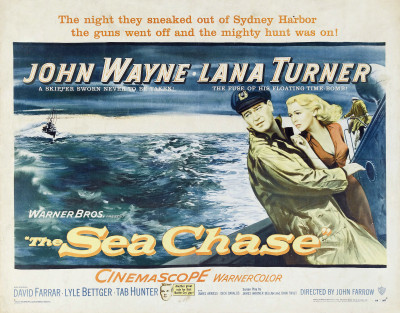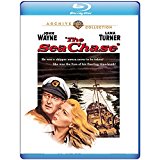| Reviews & Columns |
|
Reviews DVD TV on DVD Blu-ray 4K UHD International DVDs In Theaters Reviews by Studio Video Games Features Collector Series DVDs Easter Egg Database Interviews DVD Talk Radio Feature Articles Columns Anime Talk DVD Savant Horror DVDs The M.O.D. Squad Art House HD Talk Silent DVD
|
DVD Talk Forum |
|
|
| Resources |
|
DVD Price Search Customer Service #'s RCE Info Links |
|
Columns
|
|
|
Sea Chase, The
Recently there was a particularly heated argument on a popular Facebook friend's newsfeed over whether John Wayne was a good or terrible actor. Actor Jim Beaver argued that while Wayne's range was obviously limited, within that range he was frequently a great actor. The Sea Chase certainly exemplifies this. Though hardly on the short list of Wayne's best films, Wayne himself gives a thoughtful, intelligent performance in the type of role he was especially good at: the solitary, determined taskmaster leader of a group of men whose loyalties are tested by his relentless pursuit of a goal, in this case returning his ship and his men safely back to Germany.
Though directed by John Farrow, whose work Wayne was unhappy with, The Sea Chase bears Wayne's stamp elsewhere, including the casting of "Wayne Stock Company" actors like James Arness, Paul Fix, and John Qualen in important supporting parts. The big, ambitious film was among the earliest shot and released in CinemaScope, and has all the plusses and few of the minuses of most early ‘scope films.
Warner's Blu-ray is a big improvement over their DVD release of a dozen years ago. On big screens it looks quite epic at times, and the adaptation of the original 4-track magnetic stereophonic sound is fantastic.
John Wayne starred in two films in 1955, and in both he played the veteran skipper of an aging ship trying, against impossible odds, to flee to a safe port. Blood Alley, released in October, had Wayne whisking an entire village of Chinese peasants from their Communist oppressors, while The Sea Chase, released earlier that year, in May, found Wayne the captain of a tramp steamer one step ahead of British destroyers trying to prevent him from reaching the fatherland.
In 1939, as war breaks out in Europe, the tramp steamer Ergenstrasse is docked in Sidney, and skipper John Ehrlich (Wayne) makes preparations to slip out of the harbor in thick fog. At the last minute the German consul general orders Ehrlich to take aboard a passenger, a German spy. The spy turns out to be Elsa Keller (Lana Turner) who, under orders, had become engaged to Ehrlich's lifelong friend, British Naval officer Jeff Napier (David Farrar, affecting an odd accent that alternates between British and Australian; he also narrates).
The Ergenstrasse succeeds in eluding the harbormaster and nearby naval vessels, but is short on provisions and fuel. Against British expectations, Ehrlich steers his ship southeast to Auckland Island, to a shipwreck supply station. They find the provisions they need, but also a small band of genuinely shipwrecked British sailors. Against direct orders, first mate Kirchner (Lyle Bettger), actually a German Naval Intelligence man, secretly murders the men.
Hoping to reach the neutral port of Valparaiso, Ehrlich leads his men to the small island of Pom Pom Galli, where the crew works long hours chopping wood to feed the Ergenstrasse hungry (and normally coal-burning) engines. Meanwhile, the ship's success in eluding the British Navy becomes a worldwide sensation, though the Allies, having discovered the bodies of the men butchered on Auckland, become determined to see Ehrlich and his crew hanged.
Despite a draggy last act, when stagy, studio-bound melodrama replaces carefully measured suspense shot on location (in Hawaii), The Sea Chase succeeds on several levels. John Farrow's deliberate pacing works to the film's advantage: at sea for weeks on end, there's a lot of nervous tension, waiting and worrying about discovery. When the ship has to stop and take aboard fuel, the work is taxing and tense, though Ehrlich's solutions to various crises are sometimes ingenious. (To squelch a rat infestation, he greases ropes leading off the ship with spoiled meat.) When one sailor is mauled by a shark and contracts gangrene, there's little to do but stand around and wait for him to die. Wayne, who loved sailing in real life, is entirely at home on a big ship like this, and the supporting cast act like real, experienced sailors. Alan Hale, Jr., Claude Akins (misbilled in the credits as "Claude Akin"), John Doucette, and Tab Hunter all have small roles but each has a scene or moment to shine.
Though almost certainly unintended, there's an intriguing quality in retrospect to a subplot concerning a young cadet (Dick Davalos) who develops terminal gangrene after being attacked by a shark. Fellow cadet Wesser (Tab Hunter), clearly devastated, watches over him protectively. While it's doubtful the film's screenwriters or Farrow meant to imply any homoerotic relationship, the fact that Hunter is gay and the relationship has the same unstated quality as Charlton Heston and Stephen Boyd in the later Ben-Hur does raise an eyebrow or two.
Wayne was generously building up the career of similarly strapping James Arness, here playing a sailor who first despises Ehrlich but gradually comes to respect him. It was Arness's last movie role before accepting (at Wayne's urging), the role of Matt Dillon on Gunsmoke. Tellingly, character actor John Qualen, who specialized in thickly-accented broad character types, underplays his unusually big supporting part as the ship's engineer.
Adapted from a novel by Andrew Geer, the film carefully dodges the conundrums of John Wayne's eagerness to return home to Nazi Germany. It's emphasized again and again that Wayne's Ehrlich is staunchly anti-Nazi, and that if he can get his men back to Germany he'll likely be arrested. Early on, there's a reference to a Nazi flag astern, complete with swastika, but it's never shown. When Ehrlich decides to fly his ship's colors at one point he quickly discards a Nazi flag he finds in favor of one dating back to the Weimar Republic.
The business with Lana Turner's character, a Mata Hari type made decent by Ehrlich's basic goodness and charm, is clichéd but Wayne and Turner pull it off. Less successful is the quasi-romantic rectangle generated by David Farrar's character, which is played up in the beginning and then essentially dropped; and Lyle Bettger's Wagner-loving Nazi, who lusts after the fellow spy.
Video & Audio
Filmed in CinemaScope and Warner Color, The Sea Chase looks great, despite a couple of terrible miniature special effects of Wayne's ship. The sharpness and accuracy of the color is excellent. As with Blood Alley, cinematographer William A. Clothier has a great eye for wide screen compositions, and his lighting is quite subtle for early CinemaScope. The DTS-HD Master Audio makes the most of Roy Webb's score and has directional dialogue and effects channeled to the surround speakers. Gone is the mono French track from the DVD, along with optional subtitles in English, French, and Spanish, the Blu-ray offer English subtitles only. The sole Extra Feature is a trailer.
Parting Thoughts
The Sea Chase is a colorful, low-key suspense film that looks great on big screen televisions and projection systems. It has aged a lot better than many of John Wayne's other films from the 1950s, holding up quite well today.
Stuart Galbraith IV is the Kyoto-based film historian largely absent from reviewing these days while he restores a 200-year-old Japanese farmhouse.
|
| Popular Reviews |
| Sponsored Links |
|
|
| Sponsored Links |
|
|
| Release List | Reviews | Shop | Newsletter | Forum | DVD Giveaways | Blu-Ray | Advertise |
|
Copyright 2024 DVDTalk.com All Rights Reserved. Legal Info, Privacy Policy, Terms of Use,
Manage Preferences,
Your Privacy Choices | |||||||















